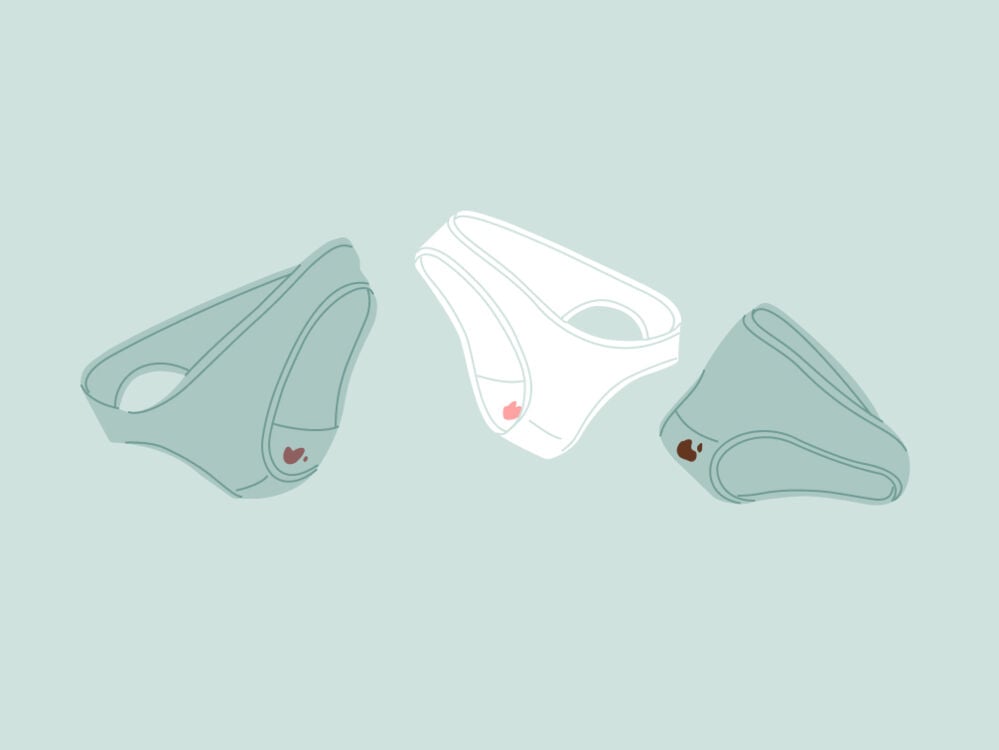It’s common for your periods to become unpredictable during perimenopause, and for some people, this can come hand in hand with spotting. Here’s why it can happen in the lead-up to menopause and how to manage it.
-
Tracking cycle
-
Getting pregnant
-
Pregnancy
-
Help Center
-
Flo for Partners
-
Anonymous Mode
-
Flo app reviews
-
Flo Premium New
-
Secret Chats New
-
Symptom Checker New
-
Your cycle
-
Health 360°
-
Getting pregnant
-
Pregnancy
-
Being a mom
-
LGBTQ+
-
Quizzes
-
Ovulation calculator
-
hCG calculator
-
Pregnancy test calculator
-
Menstrual cycle calculator
-
Period calculator
-
Implantation calculator
-
Pregnancy weeks to months calculator
-
Pregnancy due date calculator
-
IVF and FET due date calculator
-
Due date calculator by ultrasound
-
Medical Affairs
-
Science & Research
-
Pass It On Project New
-
Privacy Portal
-
Press Center
-
Flo Accuracy
-
Careers
-
Contact Us
Spotting during perimenopause: Is it normal?


Every piece of content at Flo Health adheres to the highest editorial standards for language, style, and medical accuracy. To learn what we do to deliver the best health and lifestyle insights to you, check out our content review principles.
If your menstrual cycle normally runs like clockwork, noticing spots of blood in your underwear when your period isn’t due might come as a surprise.
Spotting is blood or bloody vaginal discharge that isn’t heavy enough to require a pad or tampon. It can be quite common — around a third of women will experience what’s known as abnormal uterine bleeding in their lifetime, which can include spotting. And it can happen for a number of reasons, such as implantation bleeding in early pregnancy, polycystic ovary syndrome (PCOS), or a sexually transmitted infection (STI). But if you’re aged somewhere between your late 30s and your 50s, there could be another possible reason for spotting: You may be approaching menopause, also known as perimenopause.
Spotting is one of the signs of perimenopause that can show up alongside other more common symptoms like hot flashes and brain fog. Read on to learn more about spotting during perimenopause, and remember to always reach out to your health care provider if you’re at all worried.
Key takeaways
- It’s normal for your periods during perimenopause to become unpredictable, which means you might experience spotting.
- Spotting is typically quite light — not enough to require a pad or a tampon, for example.
- Perimenopausal changes to your hormones aside, there can be lots of other reasons why you might experience spotting — including birth control side effects or fibroid symptoms. Your doctor can help you figure out the cause, so book a checkup if you’ve noticed any changes to your cycle.
What does perimenopause spotting look like?
Spotting can be a sign of perimenopause, but you might not be completely clear on what perimenopause actually is. The terms menopause and perimenopause are often thought of as the same thing when, in fact, they’re two separate things.
Perimenopause describes the years leading up to menopause (your final period). It usually begins anywhere between your late 30s and 50s but most commonly happens in your 40s. You’re classed as having gone through menopause when you haven’t had a period for 12 months (this is usually between the ages of 45 and 55). From then on, you are postmenopausal.
Everyone is unique when it comes to perimenopause, which means no two people have the exact same symptoms, but changes to your period at this time of life are pretty common. “Spotting is bleeding noted outside of a woman’s normal period,” explains obstetrician and gynecologist Dr. Angela Jones, New Jersey, US, adding that you’ll most commonly notice it “with wiping, after sex, or on other occasions.”
Your cycle can be harder to predict during perimenopause because your periods can become irregular as they start to wind down. But spotting isn’t the same as when you get your period. The bleeding is usually lighter, so you don’t generally need to reach for a pad or a tampon. Color wise, spotting is typically light or dark brown or a pink tinge to your discharge. If you’re not sure what’s what, use a cycle-tracking app like Flo to jot down your symptoms and bleeds, and you may start to see some patterns.

Take a quiz
Find out what you can do with our Health Assistant
If you’re at all worried about changes to your cycle, then reach out to your doctor for a checkup.
What causes spotting during perimenopause?
Just like other more widely known perimenopause symptoms such as brain fog and hot flashes, spotting can happen because of changing hormone levels.
When you have regular periods, your levels of the hormones estrogen and progesterone rise and fall in a continuous cycle every month. This helps your body to prepare for a potential pregnancy, but once you hit perimenopause, your hormone production begins to change.
In particular, the levels of estrogen produced by your ovaries start to vary more than before, fluctuating between high and low levels. This up-and-down estrogen production can lead to unpredictable bleeding patterns.
“The cycle may be longer or shorter, and periods can be lighter or heavier,” says Dr. Jones. “There can be bleeding or spotting in between periods.”
If you’ve already taken steps to manage your perimenopause symptoms with hormone therapy (previously known as hormone replacement therapy or HRT) or you’re on birth control for perimenopause, it’s worth noting that these methods can result in a breakthrough bleed. This is similar to spotting, and it usually settles down within a few months.
When is spotting a concern?
If you experience bleeding between periods, don’t shrug it off. Although it’s likely nothing to worry about, spotting could also be a sign of an underlying condition.
“Any spotting that interferes with a woman’s quality of life or that persists is a concern,” says Dr. Jones. “Spotting also becomes concerning depending on a woman’s risk factor profile: specifically, obesity, Pap smear history [for example, if anything abnormal has previously been picked up during a cervical screening], and if there is a risk of an underlying infection.”
You should also visit your doctor or obstetrician and gynecologist if you experience any of the following:
- Persistent or increasing spotting
- Bleeding after sex
- Spotting that’s accompanied by dizziness, fever, abnormal vaginal discharge, or abdominal/pelvic pain
- Postmenopausal bleeding
Using a cycle-tracking app like Flo to track your periods can help you spot changes in your cycle. You can log symptoms like spotting in the app, and you’ll then get a report each cycle showing when they happened, which you can easily share with your doctor.
Other causes of abnormal bleeding
Bleeding between periods can be caused by reasons other than perimenopause. These are some of the most common:
- Hormonal imbalance: Changes to your hormones caused by things like obesity, PCOS, and thyroid problems can lead to bleeding between periods.
- Pregnancy: Complications during pregnancy can be a cause of spotting, says Dr. Jones. “This is important as some forget that you can still become pregnant during this stage in life [perimenopause].”
- Uterine Polyps: These tiny growths are sometimes found in the uterus and can cause spotting. They don’t often cause many other symptoms, and they’re noncancerous, so try not to worry if you find out you have them. Only in very rare cases, if they’re left untreated, do they go on to become more serious.
- Uterine fibroids: Similarly, these growths that form in the uterus can also lead to bleeding between periods. Most small fibroids don’t need any treatment, although larger ones may mean you need medication or, less commonly, surgery.
- Infection: An infection of your reproductive organs caused by an STI or pelvic inflammatory disease can cause spotting. These are generally treated with a course of antibiotics.
- Birth control: Some light bleeding is a common side effect of taking the pill or using a hormonal intrauterine device (more commonly known as an IUD). It shouldn’t hurt or last for long, though.
- Cancer: Much less commonly, certain types of cancer of the uterus and cervix can lead to spotting.
If you’re not sure what’s causing your spotting, book an appointment with your health care provider. They’ll be able to provide advice, put together a personalized treatment plan if needed, and direct you to the right specialist should you need one. If it is perimenopause related, they can also help you manage any other symptoms you might be experiencing too.
Can you do anything about spotting?
Unpredictable periods can be stressful and annoying for some people. Menopause (and perimenopause in the lead-up to it) is a process that all women and people with periods go through, but if unexpected bleeding is starting to interfere with your life, don’t feel like you have to live with it.
Treatment for spotting varies depending on the cause, so reach out to your doctor to discuss your options. They will likely ask you questions about your menstrual cycle, including the length and type of bleeding you experience, so having a record of it on an app like Flo can be useful.
If your doctor finds that perimenopause is responsible for your spotting, they may recommend a couple of different options. Some birth control pills have also been found to act like hormone therapy, so they can be used by some people as a two-in-one — both birth control and relief from perimenopause symptoms.
If you’re experiencing other perimenopause symptoms (like hot flashes or vaginal dryness) as well as spotting, then hormonal therapy might be an option. “Hormonal options can be used to treat spotting as well as to temper any other symptoms that can be associated with perimenopause,” says Dr. Jones. Chat with your doctor for advice, and they’ll help you weigh your options.
More FAQs
Is it normal to spot on and off during perimenopause?
Hormonal changes can lead to unpredictable bleeding patterns, including irregular or missed periods, so it’s quite normal to notice spotting on and off throughout perimenopause. That said, it’s always wise to get unexpected bleeding checked out, just so you can be sure of the cause.
Why am I bleeding only when I wipe?
Spotting or bleeding between periods is often very light, so it’s normal if the blood is only noticeable when wiping or on your underwear.
What stage of perimenopause am I in?
You may be able to tell what stage of perimenopause you are in by the length of your menstrual cycle. During early perimenopause, your cycles may start to lengthen or shorten as your hormones fluctuate. If you notice a regular change of seven days or more in the length of your menstrual cycle, then you’re likely to be in the early stages. If you go for 60 days or more without a period and you experience other telltale symptoms at this time, such as hot flashes and mood swings, you’re likely in late perimenopause. Everyone is different, though, so speak to your doctor, who will be able to give you more personalized advice.


Hey, I'm Anique
I started using Flo app to track my period and ovulation because we wanted to have a baby.


The Flo app helped me learn about my body and spot ovulation signs during our conception journey.


I vividly
remember the day
that we switched
Flo into
Pregnancy Mode — it was
such a special
moment.
Real stories, real results
Learn how the Flo app became an amazing cheerleader for us on our conception journey.
References
“Abnormal Uterine Bleeding.” Cleveland Clinic, my.clevelandclinic.org/health/diseases/15428-uterine-bleeding-abnormal-uterine-bleeding. Accessed 19 July 2022.
Clinic, Cleveland. “Bleeding between Periods? How to Tell if It’s a Problem.” Cleveland Clinic, 12 Mar. 2024, health.clevelandclinic.org/when-should-you-worry-about-spotting-between-periods.
“Combination Birth Control Pills.” Mayo Clinic, 13 Jan. 2023, www.mayoclinic.org/tests-procedures/combination-birth-control-pills/about/pac-20385282.
Davis, Emily, and Paul B. Sparzak. “Abnormal Uterine Bleeding.” StatPearls, StatPearls Publishing, 2023, www.ncbi.nlm.nih.gov/books/NBK532913/.
“Delaying Your Period with Hormonal Birth Control.” Mayo Clinic, 2 Dec. 2022, www.mayoclinic.org/healthy-lifestyle/birth-control/in-depth/womens-health/art-20044044.
Fraser, Ian S., et al. “The FIGO Recommendations on Terminologies and Definitions for Normal and Abnormal Uterine Bleeding.” Seminars in Reproductive Medicine, vol. 29, no. 5, Sep. 2011, pp. 383–90, doi: 10.1055/s-0031-1287662.
Grandi, Giovanni, et al. “Contraception during Perimenopause: Practical Guidance.” International Journal of Women’s Health, vol. 14, July 2022, pp. 913–29, doi:10.2147/IJWH.S288070.
“Hormonal IUD (Mirena).” Mayo Clinic, 11 Apr. 2024, www.mayoclinic.org/tests-procedures/mirena/about/pac-20391354.
“How To Tell You’re Near the End of Perimenopause.” Cleveland Clinic, Oct. 2022, health.clevelandclinic.org/signs-perimenopause-is-ending.
“Is Breakthrough Bleeding More Common with Extended-Cycle Birth Control Pills, Such as Seasonale and Others?” Mayo Clinic, 7 Dec. 2022, www.mayoclinic.org/healthy-lifestyle/birth-control/expert-answers/seasonale-side-effects/faq-20058109.
“Menopause 101: A Primer for the Perimenopausal.” The North American Menopause Society, www.menopause.org/for-women/menopauseflashes/menopause-symptoms-and-treatments/menopause-101-a-primer-for-the-perimenopausal. Accessed 11 June 2024.
“Menopause.” World Health Organization, 17 Oct. 2022, www.who.int/news-room/fact-sheets/detail/menopause.
“Pelvic Inflammatory Disease.” Cleveland Clinic, my.clevelandclinic.org/health/diseases/9129-pelvic-inflammatory-disease-pid. Accessed 19 June 2024.
“Perimenopausal Bleeding and Bleeding after Menopause.” The American College of Obstetricians and Gynecologists, Oct. 2020, www.acog.org/womens-health/faqs/perimenopausal-bleeding-and-bleeding-after-menopause.
“Perimenopause.” Cleveland Clinic, my.clevelandclinic.org/health/diseases/21608-perimenopause. Accessed 2 Apr. 2024.
“Perimenopause.” Mayo Clinic, 25 May 2023, www.mayoclinic.org/diseases-conditions/perimenopause/symptoms-causes/syc-20354666.
“Postmenopausal Bleeding.” Cleveland Clinic, my.clevelandclinic.org/health/diseases/21549-postmenopausal-bleeding. Accessed 19 June 2024.
“Symptoms of Cervical Cancer.” Cancer Research UK, www.cancerresearchuk.org/about-cancer/cervical-cancer/symptoms. Accessed 19 June 2024.
Thomas, Anna M., et al. “Disturbances of Endometrial Bleeding with Hormone Replacement Therapy.” Human Reproduction, vol. 15, suppl. 3,, Aug. 2000, pp. 7–17, https://doi.org/10.1093/humrep/15.suppl_3.7.
“Uterine Fibroids.” Mayo Clinic, 15 Sep. 2023, www.mayoclinic.org/diseases-conditions/uterine-fibroids/symptoms-causes/syc-20354288.
“Uterine Fibroids.” Cleveland Clinic, my.clevelandclinic.org/health/diseases/9130-uterine-fibroids. Accessed 15 Feb. 2022.
“Uterine Polyps.” Cleveland Clinic, my.clevelandclinic.org/health/diseases/14683-uterine-polyps. Accessed 19 June 2024.
“Vaginal Bleeding between Periods.” MedlinePlus, medlineplus.gov/ency/article/003156.htm. Accessed 19 June 2024.
“Vaginal Bleeding.” Cleveland Clinic, my.clevelandclinic.org/health/symptoms/17899-vaginal-bleeding. Accessed 19 June 2024.
“Vaginal Bleeding.” Mayo Clinic, 2 May 2023, www.mayoclinic.org/symptoms/vaginal-bleeding/basics/definition/sym-20050756.
“Womb (Uterus) Cancer: Symptoms.” NHS, www.nhs.uk/conditions/womb-cancer/symptoms/. Accessed 19 June 2024.
History of updates
Current version (24 June 2024)
Published (24 June 2024)
In this article

Track your perimenopause journey in the Flo app
-
Log symptoms and get tips to manage them
-
Learn what to expect with expert-led articles and videos
-
Connect with others who can relate to how you're feeling




